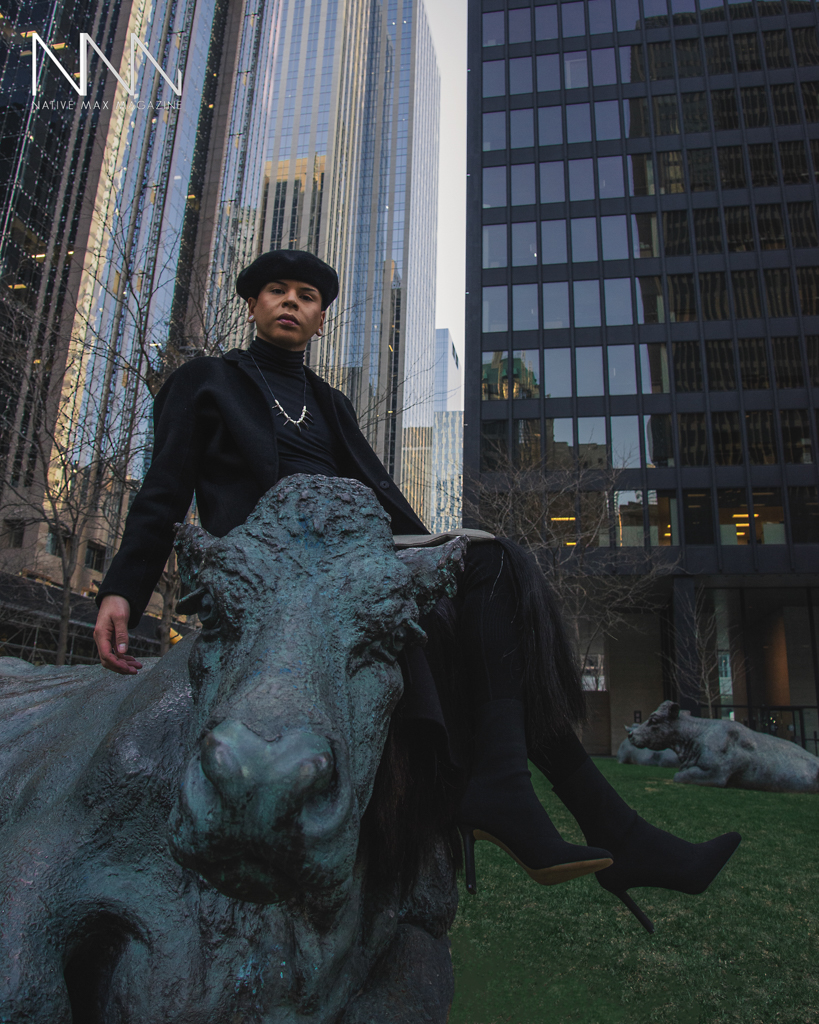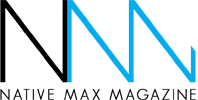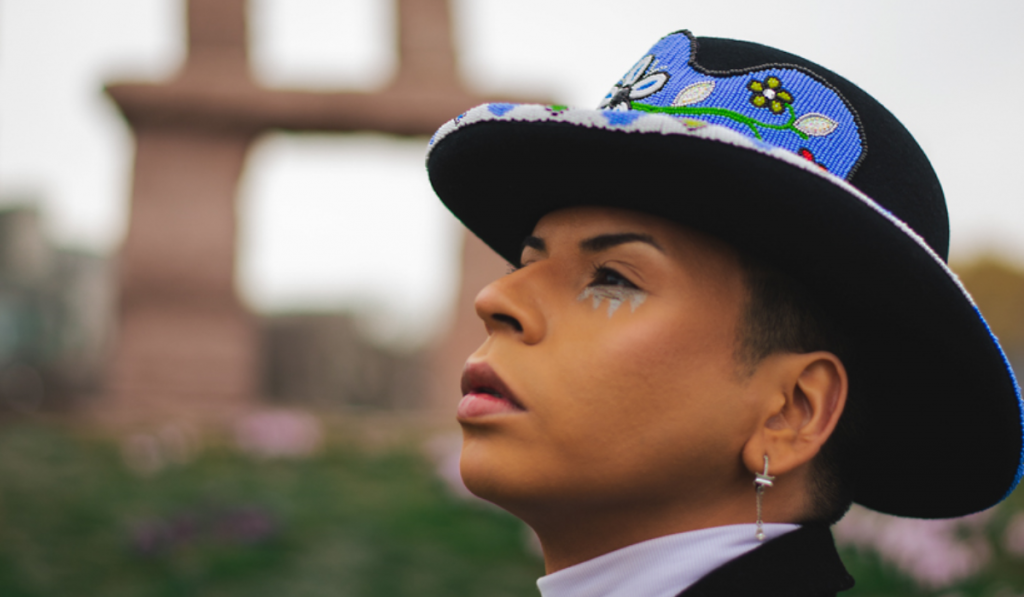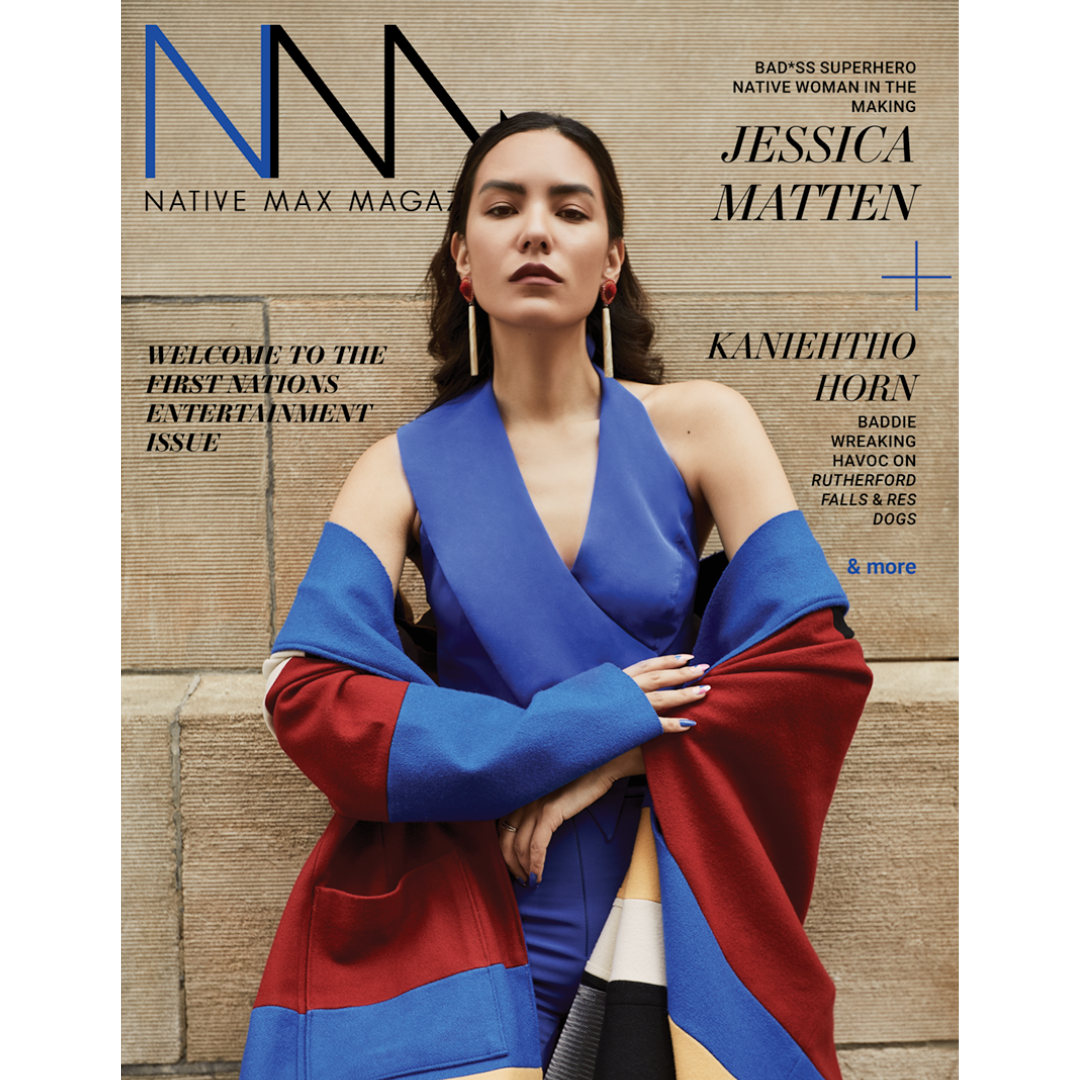Growing up on a rural reserve, he struggled with his identity and was bullied, flipping through pages of fashion magazines as the only form of escapism. Now, Cree youth Scott Wabano is taking on the fashion industry as a model, fashion stylist, and fashion designer while gracing the cover of the first Native fashion magazine, Native Max. We sat down with Scott for an exclusive interview about his fashion career journey, what inspired him to pursue fashion and how he presents his culture and fashion.
Scott grew up in the rural community of Moose Cree First Nation territory, located on the west side of James Bay. Scott struggled with their identity throughout his childhood, including being bullied for being “too feminine.” That led to Scott finding a sort of escapism in fashion and pop culture magazines; flipping through the pages allowed him a glimpse of the outside world beyond the borders of the reserve. Yet, there was a lack of connection and acceptance as there were no Native American or First Nations models or fashion inside the magazines. Inspired, Scott decided to move to Toronto to pursue a career in fashion.

Now, Scott expanded their fashion career as a model, fashion stylist, and fashion designer. His resume exhibits closely working with major fashion companies and styling national campaigns, including designing his own fashion brand, WABANO. Aside from helping create safe spaces for LGBTQ2S+ youth in urban settings, Scott makes social media content that helps others who live in rural areas connect experiences.
Scott is undoubtedly influencing Native fashion while breaking barriers of being a Cree two-spirit youth taking on the fashion industry.
Please share with us a bit of yourself.
Where do I start?
First and foremost, my name is Scott Wabano. I’m a two-spirit Eeyou’d, from the Cree Nation of Waskaganish but born and raised in the Moose Cree First Nation territory. I currently reside in the Treaty 13, Dish with One Spoon Treaty Territory known as Toronto, Ontario, Canada, where I work as a Fashion Stylist and Creative Director for my brand, Wabano.

Throughout my life, I’ve always had a passion for my community and the arts. It led to many opportunities, some great ones including becoming a National Ambassador of Hope for the We Matter Organization, an Indigenous-youth-led organization here in Canada dedicated to Indigenous Youth support, hope, and life promotion. I guess you can say I’ve lived quite a nomadic life. I moved a lot throughout my life, figuring out what I wanted to do with my life and who I was as an individual. It took me a while to fully embrace who I was as a two-spirit Eeyou’d. At the time, I didn’t know my two-spirit identity and just identified as a gay man. That took some time as well, but fortunately, I’ve lived a very privileged life of having a family who accepted me and a family I didn’t necessarily have to come out to. That is a privilege not many gay, let alone two-spirit and LGBTQ+ people have these days. Especially where I come from, it’s still very taboo to be out and proud, and sadly a lot of youth and their mental health suffers because of it. There’s still a lot of harmful colonial behavior within Indigenous communities, so I try my best to let youth know that they can overcome that.

What is your tribe? Where are you from?
I am an Eeyou’d from the Eeyou Istchee territory. Both of my families are from the Cree Nation of Waskaganish and Moose Cree First Nation. My great grandparents also had ties with Attawapiskat First Nation, but they relocated to find work like most families. So my families from Quebec and Attawapiskat migrated to the Moose Cree First Nation territory, where my grandparents worked as trappers and craftspeople.
You work so closely in the Native fashion community. When did you become interested in fashion?
Growing up, fashion has always been a part of my life, especially from the matriarchs in my family. My late kokum (grandmother in Cree) was an amazing craftswoman. Every time I think of her, I always remember the smell of moose hide used to fill the room when she would work on her crafts. She used to create a lot of clothing for my family and stuff to sell as well. Through that, it passed down to my mom making my powwow regalia together growing up. My aunt from my dad’s side also played a very instrumental role in my love for fashion and regalia as she used to help create mine. So that’s my background in Native fashion, I guess you can say.
Growing up, I was bullied a lot for being who I was. I was a very feminine child who had long black hair. There weren’t many youths in my community who were powwow dancing at the time, so they didn’t understand why I had long hair or what powwow dancing was, let alone what two-spirit meant at that point. I didn’t even know I was two-spirit, but I knew I was different. From that, it led to me finding a sort of escapism in fashion and pop culture magazines. Browsing through the pages, the red carpet photos always fascinated me. What people wore, who people wore, and why particular designers were such “household names.” Browsing through these pages, though, there was not one Indigenous person I saw, which also led me to wonder why. And I remember being a kid thinking, “I want me and my friends to be in these magazines. I want to see Indigenous people in these magazines, on these runways and red carpets, on billboards, and wherever we see mainstream fashion.” I always knew that it’s very personal and unique to us regarding Indigenous peoples and our fashion. A lot of our designs for regalia or even names come to us in various forms: dreams, ceremonies, prayers, it’s very intertwined with our identities and our teachings. I always felt like that should be shared with the world. We’re significantly underrepresented, and that needs to change.

How about modeling; what do you love about modeling?
Modeling is honestly really fun as well! It gives me a chance to break out of my comfort zone, which I’ve always been a fan of doing. There’s just something powerful about it as well. When reflecting on history books of Indigenous people, you see a lot of photos of our ancestors just looking all deadly, resilient, and beautiful. I always think of that when I model. There’s a sense of empowerment when you model. It’s good to channel all that energy and confidence through modeling.
Besides modeling, you are also a fashion stylist as well as a fashion designer. Which one do you prefer over the other? How are you able to express yourself between each one?
It’s so hard to compare the two because I love them both for different reasons. And they both go hand in hand as well. I feel like if you are a fashion designer, you’re also a stylist at the same time because you’re also picturing how your designs would be worn, what accessories would go with them, who will wear your designs, and so much more. With designing, I can share my messages, visions, and dreams with the world. With styling, the focus is less on me and more on the other person, whether it’d be a model, client, or designer. With styling, I can see the vision of what my client wants and translate that through my own personal fashion lens into what I think they would like, hopefully executing what their vision was. Styling or designing? I honestly love them both equally!

Please share with us your journey working in the fashion industry so far.
It’s been a long one, so brace yourself.
Well, it all started when I left my nation to pursue my college degree in Toronto in 2017. I was studying Fashion Arts and Business at Humber College, which led me to meet many people from different cultures, which is what I love about Toronto! Through that, I started attending networking events around the city. Being fashion students, we often got tickets to go to fashion shows and fashion weeks. I also was a social media manager for my school’s fashion magazine, which brought some fantastic networking opportunities. I ended up finding an internship with Vitaly Design, a national jewelry company, working as their wholesales intern under their sales department. But because it was a full-time, paid internship position, it led me to drop out of my college program in July 2017, where I worked with them for a couple of months.
Unfortunately, our department got shut down, so I ended up moving back to Waskaganish in October 2017. While I was up there, I decided to try and start my clothing line then. I launched a couple of tees and beanies, but I was also launching during the worst time to launch a new business: during the holidays. So that didn’t end up well. It also led to horrible partnerships with former suppliers because I wasn’t too knowledgeable on the business side, so that screwed me over. I knew I wanted to go back to school because I always had that mindset of “finish what you started,” so I stayed in Waskaganish for a bit to save money and went back to school in Toronto in January 2019.
Ever since I got back, it was just a strict motivation to learn. From anywhere and anyone I could meet. I started back at my college program and joined the Fashion Group International Toronto, which led to many networking opportunities again. That’s what I noticed about the fashion industry; it’s all about networking. It’s very intimidating sometimes, especially being a two-spirit person.

I started to reach out to people, and that’s how I started working with Manitobah Mukluks as a store manager. That’s also around the time I began to work for Lesley Hampton and was also interning for her on the side. She’s played a massive role in my journey in fashion. She’s taught me so much and has shown me the ins and outs of the Toronto fashion industry. Through that, it led to a collaboration, to now a friendship. Lesley and I always just had a close connection when it came to fashion and our people. As Indigenous designers, I feel like it’s always ingrained within us. I mentioned to Lesley that I wanted to get more experience as a stylist, so that’s when she started getting me to style all of her lookbooks and campaigns. It was so fun and so honored for her to trust me with that. It’s been about a year of styling Lesley’s lookbooks now, and I’ve also styled her for a couple of interviews pre-COVID.
Significant projects I have styled so far would be the Indigenous Fashion Week Toronto 2020 Campaign and Sephora Canada’s Indigenous History Month Campaign, to name a few. It’s been such a wild ride of styling, but designing is a whole other ride that I’m excited to take. I launched The OFFiCiAL Collection on May 7th, and it was sold out by the end of the day on May 8th. Now that was also so wild to me and still something I’m still trying to process. It’s been quite a journey so far, but I’m so grateful, honored, and excited for the opportunities. It just means that people are finally seeing that we are meant to be in these spaces our people weren’t in before. There’s a shift and change happening within the industry, and it’s beautiful, and I’m honored to be a part of that change.
What was the inspo and moodboard behind your cover shoot? Tell us all about it!
“The Wearer of Many Hats” basically summarizing my entire life. It’s been a journey to get to where I am, and I wasn’t always in fashion. I’ve carried a lot of roles throughout my life that I think helped me become the person I am today. As a business owner, you’re also taking many roles: your own accountant, your own PR, your own administration, your own manager, etc. It gets super tiring, but it’s a part of the job. Toronto has been a very key place in my journey. Within fashion, within life, and even with finding my identity as a two-spirit person. I wanted to pay homage to that. It reflects my personal style as well too. As you might probably tell, black is my favorite color, and in my everyday wardrobe, whether I am working on a shoot or just out with friends, you will always find me dressed in black and a hat.

How are you able to showcase your culture and heritage through fashion?
As indigenous people, fashion has always just been a part of our way of life. It’s always been tied within our identity, our family, and our communities. As time passed, many nations throughout the globe had to adapt to the western world and all of its technology. Even though our worlds evolved, our people still hold their knowledge, values, and ways of life closely. Reflecting on my designs, using quotes such as “My Queerness is Traditional” and “My Existence is the Resistance” not only is sending a very clear statement of who I am and what my identity means to me, but how other Indigenous people or BIPOC people should be viewing their existence. Using cones that you would typically see on a jingle dress or any other form of garment and jewelry made by many nations and incorporating within a modern motto bomber design is another straightforward way of integrating something close to me into my fashion too. We are living in an age where much Indigenous youth are learning to live in both worlds. I am an Indigenous youth adjusting to that, so I want to wear and see fashion that reflects that.
You are also a growing influencer on social media. What made you turn to post on social media? What has your journey been like so far, being so active on social media?
Well, it all started when I left my home community which was back in high school. Being away from my family, I had to use social media to keep them updated on my life, so they didn’t think I was dead. As awful as that sounds, that’s basically why. Through that, I also started to grow a following, and people began to notice who I was and enjoy my content which I thought was weird. But it also taught me the power of social media and how to use it positively to help Indigenous people living in isolated communities. When reflecting on my time living on the reservation, social media was one of my forms of staying connected or feeling connected to other people worldwide. I struggled with my identity growing up, so it was hard for me to connect with people around me. Social media was a way for me to connect with others who share the same issues that I was facing or like the same things that I did. So when I reflect on that, I want to be that same person for other Indigenous youth living in communities. So far, my journey has been nothing but great, and I’ve been blessed to have people that have been supportive and loving and only want to see me thrive. It’s so easy to get caught up in the negative side of social media, but it’s essential to have the right support system around you and the proper grounding techniques to make sure none of that interferes with your life. Not going to lie; there are times where I want to delete my social media because of the amount of negativity I see on it, but I always remind myself of my time on social media as a child and how alone it didn’t make me feel.

In what ways do you plan on contributing to the future of your people? Why are you the future?
I think just being who I am and where I am contributes to our people’s future. We have never seen our ancestors occupying the spaces our people are occupying today. It is now the time for our people to reclaim the spaces and reclaim these narratives fully, and I’m one of the few people who are doing that. So many Indigenous youths worldwide are standing up and ensuring the world is a better place for all. Creating safe spaces so other youth can come and occupy these, where they can walk into an industry and not have to question if they deserve to be there because we do; if not, we deserve to be running that sh*t.
Why do community leaders need to provide more opportunities for Native youth to grow and succeed? How can community leaders help you?
There’s still a lot of colonial views within our communities. True community leaders don’t need to provide more opportunities for youth; they do it. Creating mentorship programs, whether for our economic development or cultural development, starts with our leaders educating our youth and providing them with the proper knowledge and tools for them to succeed.









